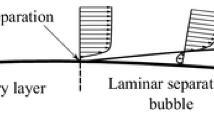Abstract
This paper presents a flutter analysis for the supercritical CAST 10-2 airfoil in a flow with free boundary layer transition based on CFD computations with the \(\gamma \)-\(\hbox {Re}_{\theta }\) transition model. The results are compared to fully turbulent results obtained with the SST \(k\)-\(\omega \) turbulence model. Unsteady RANS computations at \(\hbox {Re}_{\rm{c}} = 2 \times 10^{6}\) are used to determine the aerodynamic derivatives. These derivatives are required to identify the flutter boundary for a 2 degree-of-freedom model by a k method. The transonic flutter boundary decreases for a flow with free boundary layer transition compared to a fully turbulent flow in the vicinity of the transonic dip. However, the flutter boundary at subsonic Mach numbers is raised for a transitional flow. In addition, the transitional frequency response is discussed: an aerodynamic resonance in connection with an instability of the transition region is observed and the possibility of a 1 degree-of-freedom flutter for transitional flows is shown.












Similar content being viewed by others
References
Bendiksen, O.O.: Transonic flutter and nature of the transonic dip. In: Proc. IFASD 2001, vol. 2, pp. 273–286. Madrid (2001)
Bisplinghoff, R.L., Ashley, H., Halfman, R.L.: Aeroelasticity, 1st edn. Dover Publications, Mineola (1996)
Braslow, A.L.: A history of suction-type laminar-flow control with emphasis on flight research. In: Monographs in Aerospace History #13. NASA History Division, Washington (1999)
Dietz, G., Schewe, G., Mai, H.: Experiments on heave/pitch limit-cycle oscillations of a supercritical airfoil close to the transonic dip. J. Fluids Struct. 19(1), 1–16 (2004)
Dress, D.A., Johnson, C.B., McGuire, P.D., Stanewsky, E., Ray, E.: High reynolds number tests of the CAST 10–2/DOA 2 Airfoil in the Langley 0.3-meter transonic cryogenic tunnel—phase I. NASA TM-84620, Hampton (1983)
Hebler, A., Schojda, L., Mai, H.: Experimental investigation of the aeroelastic behavior of a laminar airfoil in transonic flow. In: Proc. IFASD 2013, 32C (2013)
Krause, M., Behr, M., Ballmann, J.: Modeling of transition effects in hypersonic intake flows using a correlation-based intermittency model. In: 15th AIAA International Space Planes and Hypersonic Systems and Technologies Conferences. AIAA, Dayton (2008)
Langtry, R.B.: A correlation-based transition model using local variables for unstructured parallelized CFD codes. Ph.D. thesis, University Stuttgart (2006)
Langtry, R.B., Menter, F.R.: Correlation-based transition modeling for unstructured parallelized computational fluid dynamics codes. AIAA J. 47(12), 2894–2906 (2009)
Langtry, R.B., Menter, F.R., Likki, S.R., Suzen, Y.B., Huang, P.G., Völker, S.: A correlation-based transition model using local variables—part II: test cases and industrial applications. J. Turbomach. 128(3), 423–434 (2004)
Mai, H., Hebler, A.: Aeroelasticity of a laminar wing. In: Proc. IFASD 2011 (2011)
Malan, P., Suluksna, K., Juntasaro, E.: Calibrating the \(\gamma \)-\(\text{ Re }_{\theta }\) transition model for commercial CFD. In: Aerospace Sciences Meetings. American Institute of Aeronautics and Astronautics (2009)
Menter, F.R.: Two-equation eddy-viscosity turbulence models for engineering applications. AIAA J. 32(8), 1598–1605 (1994)
Menter, F.R., Langtry, R.B., Likki, S.R., Suzen, Y.B., Huang, P.G., Völker, S.: A correlation-based transition model using local variables—part I: model formulation. J. Turbomach. 128(3), 413–422 (2004)
Mineck, R.E.: Comparison of NAE porous wall and NASA adaptive wall test results using the NAE CAST-10 airfoil model. In: Ray, E.J., Hill, A.S. (eds.) CAST-10-2/DOA 2 Airfoil Studies Workshop Results, CP-3052, pp. 195–212. Hampton (1989)
Misaka, T., Obayashi, S.: Application of local correlation-based transition model to flows around wings. In: 44th AIAA Aerospace Sciences Meeting and Exhibit. AIAA, Reno (2006)
Nitzsche, J.: A numerical study on aerodynamic resonance in transonic separated flow. In: Proc. IFASD 2009 (2009)
Ray, E.J., Hill, A.S.: CAST-10-2/DOA 2 Airfoil Studies Workshop Results. CP-3052. NASA, Hampton (1989)
van Rooij, A.C.L.M., Wegner, W.: Flutter behaviour of a laminar supercritical airfoil—a numerical investigation into the influence of boundary layer transition. In: Dillmann, A., Heller, G., Krämer, E., Kreplin, H.P., Nitsche, W., Rist, U. (eds) Notes on numerical fluid mechanics and multidisciplinary design, vol. 124, pp. 33–41 (2014)
Schwamborn, D., Gerhold, T., Heinrich, R.: The DLR TAU-code: recent applications in research and industry. In: Wesseling, P., Oñate, E., Périaux, J. (eds.) Proc. European Conference on Computational Fluid Dynamics ECCOMAS. Netherlands (2006)
Seyfert, C., Krumbein, A.: Evaluation of a correlation-based transition model and comparison with the \({{\text{ e }}^{{\rm N}}}\) method. In: 40th Fluid Dynamics Conference. AIAA, Chicago (2010)
Stanewsky, E., Demurie, F., Ray, E.J., Johnson, C.B.: High reynolds number tests of the CAST-10-2/DOA 2 transonic airfoil at ambient and cryogenic temperature conditions. In: AGARD Conference Proceedings: wind tunnels and testing techniques 348, pp. 47–60 (1984)
Stanewsky, E., Zimmer, H.: Development and wind tunnel investigation of three supercritical airfoil profiles for transport aircraft. NASA TM-75840, Washington, DC (1980)
Wright, J.R., Cooper, J.E.: Introduction to aircraft aeroelasticity and loads. Wiley, West Sussex (2007)
Acknowledgments
This work was funded by Deutsches Zentrum für Raumfahrt (DLR) programmatic research in the project ALLEGRA.
Author information
Authors and Affiliations
Corresponding author
Appendix
Appendix
Rights and permissions
About this article
Cite this article
Fehrs, M., van Rooij, A.C.L.M. & Nitzsche, J. Influence of boundary layer transition on the flutter behavior of a supercritical airfoil. CEAS Aeronaut J 6, 291–303 (2015). https://doi.org/10.1007/s13272-014-0147-7
Received:
Revised:
Accepted:
Published:
Issue Date:
DOI: https://doi.org/10.1007/s13272-014-0147-7








